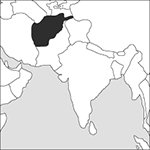
Source: MAPS IN MINUTES™ © RH Publications (1997)
Capital:
Kabul
Area:
652,225 sq km (251,825 sq miles)
Population:
30,419,928 (2013 est)
Currency:
1 afghani = 100 puls
Religions:
Sunni Muslim 80.0%; Shiite Muslim 19.0%
Ethnic Groups:
Pathan (Pashto) 42.0%; Tajik 27.0%; Uzbek 9.0%; Hazara 9.0%
Languages:
Pashto, Dari (Persian) (both official); minority languages
International Organizations:
UN; Colombo Plan; Non‐Aligned Movement
A mountainous and landlocked country in south‐central Asia, bounded on the west by Iran, on the south and east by Pakistan, on the east by China, and on the north by Turkmenistan, Uzbekistan, and Tajikistan.
Physical
Afghanistan’s eastern region is dominated by the vast mountain range of the Hindu Kush and most of the country is high plateau. In winter much of it is under snow; in spring grass appears, which is scorched dry and swept by the dust storms of summer.
Economy
Agriculture, mainly sheep‐raising and subsistence farming, is the mainstay of the economy, which has been devastated by nearly 30 years of civil war. The illegal cultivation of opium poppies is now the country’s main source of income.
History
Afghanistan was conquered by Alexander the Great, and after his death became part of the Bactrian state. A succession of foreign overlords was followed by Arab conquest from the 7th century. The territory was converted to Islam and the most important Muslim ruler was Mahmud of Ghazna. The country was overrun by Mongols in 1222, only becoming united under an Afghan leader in 1747, when Ahmad Shah founded the Durrani dynasty at Kandahar. In the 19th and early 20th centuries Afghanistan was the focal point of conflicting Russian and British interests. A British attempt to replace the Kabul ruler Dost Muhammad was repulsed in the First Anglo‐Afghan War, but Afghan foreign policy came under British control in 1879 by the Treaty of Gandamak, when Britain gained control of the Khyber Pass. In 1880 Abdurrahman Khan became amir, establishing a strong central government; Afghanistan achieved independence from Britain under his heir, Amanollah Khan, in 1919. In 1953 General Mohammad Daoud Khan seized power and was Prime Minister until 1963, during which time he obtained economic and military assistance from the Soviet Union. There were border disputes with Pakistan, but it was Daoud’s policy to maintain ‘non‐alignment’ between the two superpower blocs. In 1964 Afghanistan became a parliamentary democracy, but a military coup in 1973 overthrew the monarchy and Daoud reasserted control. In 1977 he issued a constitution for a one‐party state. Within a year, however, he had been assassinated and the Democratic Republic of Afghanistan proclaimed, headed by a revolutionary council, whose first President was Nur Mohammad Taraki. The new regime embarked on reforms, causing some rural unrest. In February 1979 the US ambassador was killed and one month later Taraki was assassinated by supporters of the deputy Prime Minister, Ha’zullah Amin, who sought US support. In December 1979 Soviet troops entered the country. Amin was killed and replaced by Babrak Karmal. Guerrilla Mujahidin forces, equipped with US arms, then waged a jihad or holy war against government troops armed and supported by Soviet forces. Some six million refugees fled to Iran and Pakistan. In 1987 the Soviet Union began to disengage, all troops being withdrawn by 1989, when the pro‐Soviet government of Mohammad Najibullah was replaced by an Islamic state. However, civil conflict between both rival Mujahidin factions and other militant groups continued. In 1995–96 the Taliban militia, an army of young Islamic militants, gained control of southern Afghanistan, including Kabul, and imposed strict Islamic law. By 1999 they had effectively defeated their rivals in the north (the Northern Alliance) and controlled some 90% of the country. In late 2001 Afghanistan came under heavy air attack from the USA after the Taliban refused to hand over Osama Bin Laden, whose Afghan‐based al‐Qaeda organization was held responsible for the terrorist attacks on the USA on September 11, 2001. The Taliban regime collapsed and the Northern Alliance occupied Kabul and other cities. An interim government was established that relied on US and (from 2003) NATO forces to maintain security. Hamid Karzai became President in 2002. A democratic constitution was adopted in January 2004, and in October Karzai was victorious in the country’s first direct presidential election; he was re-elected in 2009. The country’s first parliament in over 30 years met in late 2005. However, Taliban resistance had not been quelled and guerrilla activity revived in the mid-2000s, especially in southern Afghanistan. Increased NATO troop deployments recovered some territory but failed to defeat the Taliban. In 2011 NATO began to transfer security responsibilities to the Afghan army with the aim of withdrawing all NATO forces within three years. The international combat mission ended in 2014. Ashraf Ghani was elected President in 2014 and held informal talks with Taliban representatives in May 2015.